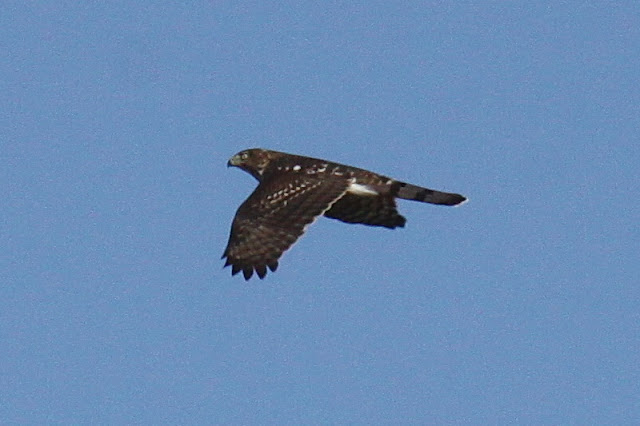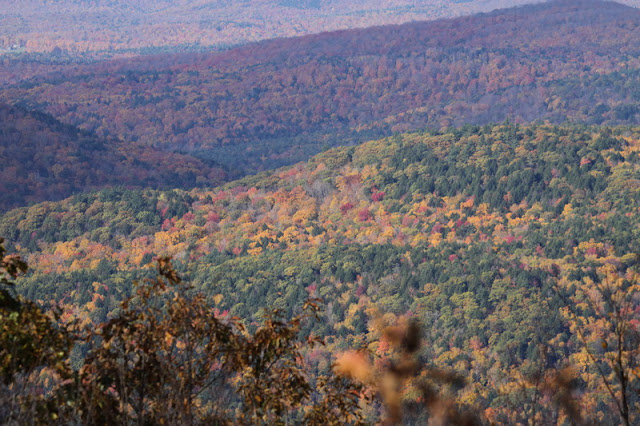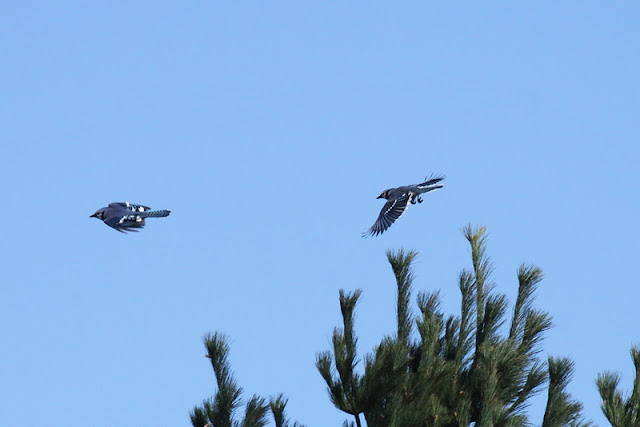 |
| Winter finches - Pine Siskin & Purple Finch |
In broad terms, a winter finch is one of a group of closely related seed eaters that lives in the northern forests and does not migrate. Instead, it leaves its normal wintering area and irrupts, usually southward, in an irregular pattern from year to year depending upon food supplies.
Migration is a fairly regular and predictable pattern. For example, the wood warblers, having raised their families, began leaving in August. They will migrate to the tropics where they will winter. Next spring, they will migrate north to their breeding grounds. It is a pattern which repeats itself year after year.
Irruptive species do not follow a regular pattern. They may stay in the same area throughout the year. Or during the winter they may move suddenly south a short distance, or a long distance. They may move east, or west ... depending upon where the food is.
Generally, the winter finches include these species: Purple Finch, Pine Siskin, Pine Grosbeak, Evening Grosbeak, Common and Hoary Redpoll, Red and White-winged Crossbill. Non-finch species which may irrupt are Blue Jay, Red-breasted Nuthatch, and Bohemian Waxwing.
 |
| Pine Siskin - mid-April, 2009, South Newfane, VT |
Let’s focus on Pine Siskins. In the winter of 08-09, they were common in my backyard, often filling every perch on the thistle feeder and the black-oil sunflower feeder, and crowding the platform feeder. Even in the middle of April, they were picking seeds out of the melting snow.
From May, 2009, until mid-October, 2010, I did not see one single Pine Siskin in my backyard, or for that matter, anywhere in New England. Beginning this Fall in early October, there were reports of Pine Siskins in the north of Vermont. The reports gradually moved southward. On October 18, there were eight siskins at my feeders. The numbers increased during the ensuing week so that often the siskins were the most common bird dining in my yard. It may be that this will be a good winter for seeing Pine Siskins, a winter finch.
 |
| American Goldfinch and Pine Siskin |
If you have goldfinches at your feeders, watch them closely. They have changed from their bright yellow summer plumage to their olive-drab winter plumage. They are dull, nondescript little birds. Some of those goldfinches may be streaked, much the way sparrows are streaked. They may have a more pointy beak, and may have bits of yellow in their wings. If you see a goldfinch like this - a “goldfinch in camouflage” as Kaufman puts it - you are actually seeing a Pine Siskin. The two species are very closely related; they exhibit similar behavior and often flock together. One striking contrast between the Pine Siskin and the American Goldfinch is when they breed. The siskin begins breeding in late March and early April. In our area, the goldfinch is one of the last species to breed, often not beginning until mid-July.
The October presence of Pine Siskins in New England is contrary to the forecast. For a number of years, Ontario Field Ornithologists have gathered information about seed crops, breeding success, and population numbers from naturalists, researches, volunteers, and the staff of the Ontario Ministry of Natural Resources. This gathered data provides the basis for the annual “Winter Finch Forecast.”
Here is the forecast for Pine Siskins: Pine Siskins favor the cones of the white spruce, and where the cone crop is abundant, the birds are likely to be found during the winter. Siskins are considered to be an opportunistic nomad. They go where their preferred food is most readily found. “Banding recoveries show that siskins wander from coast to coast searching for conifer seed crops. They were uncommon this past summer in Ontario and the Northeast. Some might winter in northern Ontario where the white spruce crop is heavy. However, siskins are currently uncommon in the Northeast so there are potentially only very small numbers that could irrupt south in eastern North America.”
 |
| Young Pine Siskin, mid-August, 2007, South Newfane, VT |
In Vermont the boreal forest is at its southern limit; it is often fragmented on mountain tops. The population of the boreal species (as with all species whatever their habitat) can vary significantly from year to year, depending upon weather and food supplies. Of course, this includes the population of the Pine Siskins. Some years the siskin may be common, and other years it may be all but impossible to find. It is not unusual that a year will go by when an active bird watcher does not see this bird.
Pine Siskins were reported as uncommon in Ontario during the past summer. They also have plenty of natural food in the northern parts of the province. The forecast for an irruption suggests that it is unlikely for our northen neighbors. Nevertheless, it does appear that siskins are irrupting into New England; they are certainly are more common this year than last year.
 |
| Bratty, little pipsqueak |
I’ll return to other winter finches in the future.
Good birding!















































